Making a Difference
Nearly 300 Alumni Have Served in the Peace Corps
March 24, 2009
By Pamela McLaren
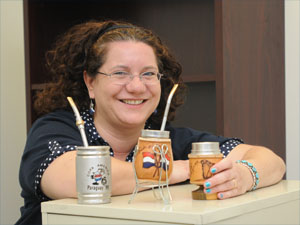
Sharyn Obsatz, now a faculty member on campus, displays some of the mementos she brought back from Paraguay.
Sharyn Obsatz spent part of her honeymoon in San Lorenzo, a city in Paraguay where she previously served as a Peace Corps volunteer.
Returning with her new husband "was very emotional,” said Obsatz (M.A. communications ’06), who now is a Cal State Fullerton communications lecturer. “I wanted to share with him what it was like, what I had experienced.”
Obsatz, who served in a poor neighborhood in Paraguay's second-largest city, was the first U.S. citizen that many there had ever met. They remembered her and were happy that she had returned, but she was sad because the situation for the barrio had not changed much from when she had been there.

Sharyn Obsatz shares a light moment with two of the boys she worked with during her Peace Corps tour in Paraguay.
Obsatz went to the South American community in 1997** to work with urban youth. She was 26 years old at the time, a working journalist who had covered “teens in trouble, in gangs, running away from home, getting arrested, getting pregnant, dropping out of school, always pulling themselves down.
"I wanted to stop being an observer and start getting involved," she wrote in a 1999 news story about her two years in the Peace Corps.
“When you are in your 20s, you have an urge for excitement, a desire to explore,” she said. “The Peace Corps is really a good way to do that. You get to know a place like you never would as a tourist. It makes you appreciate what you have here.

Sharyn Obsatz, right in the back, spent lots of time working with youth during her two years in San Lorenzo as a Peace Corps volunteer.
“I learned a lot about myself and the world,” Obsatz remembers. “In those days I was so sure of issues, saw things as black or white before I went to Paraguay. It helped me to see the world as more complex, more shades of gray.
“It made me believe in small changes,” said Obsatz about her experience. “It doesn't have to be all good to love it.”
At present, 15 Cal State Fullerton alumni are spending their days in foreign lands as volunteers in the Peace Corps. They are part of a volunteer force that numbers nearly 8,000.
They follow in the footsteps of nearly 300 fellow alumni, who have served in 76 countries — from Albania to Zambia — around the world since the organization’s beginnings in 1961.
These are just a few of the stories of those who have, who are and who will be serving in the Peace Corps.
Exploring Options, Seeking Direction
Alumna Lorraine Gunderson, who is serving in Moldova in Eastern Europe, graduated in 2004 with a bachelor's degree in psychology but found herself still questioning what she wanted to do with her life.
“Become a therapist, become a journalist, write a novel? The last three and a half years zoomed by so fast and I was still no closer to knowing where I wanted to be or what I wanted to do,” she explained. At the same time, her room mate graduated and got an internship in Portugal. It prompted her to consider a possible internship as well.
“Traveling the world was always something I'd wanted to do,” Gunderson said. She considered other volunteer programs and then turned to the Peace Corps.
“I began researching online and felt the program was exactly what I needed. I filled out the application, had an interview and then, six months later, was living in Eastern Europe.
Gunderson arrived last June in the capitol of Chisinau and lived in a nearby village for 10 weeks while being trained and learning the language. In August, she passed the language test and moved to the another village in the south where she serves as a health educator, teaching basic health to students in fifth- through 10th-grade.
She also works with the village's medical center, leading health seminars for adults “so that the audience will be engaged, learn and actually use the information we’re giving them,” Gunderson explained. “I also teach them about how to evaluate the resources they have and utilize them in better and more efficient ways.
In addition, “I am working with a woman, who is the equivalent of the PTA president for the school I work in, on two community projects. The first will be to put in a toilet at the school and repair or replace the outhouse, so we don’t lose any children in the giant holes!” she said. “I also want to build a recreation center for the kids in the community. There is literally nothing productive for these kids to do after school let’s out. My partner and I are looking into whether we’ll be able to find funding to get that done."
Meanwhile, she has formed a student club, working with a group of eighth- and ninth-grade students.
“We're working on a puppet show about the dangers of smoking to put on for the fourth grade right now. I love going to school on Wednesdays because I have the ninth grade class followed immediately by the club meeting and, to be honest, the ninth grade class is my favorite.
“There are three boys, Ion, Gheorge and Boris, who are so funny, they're like the three Stooges. Whenever Ion see’s me he yell’s ‘Ms. Lori’ and then runs over and gives me air kisses,“ she explained. “Then Gheorge tells me about his love life — at least I think that’s what he’s talking about. He talks so fast, I hardly understand him. Then there’s Boris, who’s just adorable and apparently stopped smoking after our month of anti-smoking classes.”
While Gunderson didn't think she had any expectations going to Moldova, “it turned out that I really did,” she admitted. “Moldova is not what I expected.”
Gunderson said that her challenge has been psychological. "It's about getting the people to believe they have the power to change their situation. It’s a lot harder than I expected it was going to be but this place and these people have so much potential that once that nut is cracked, there's no limit to what they can do.”
From Childhood Dream to Reality
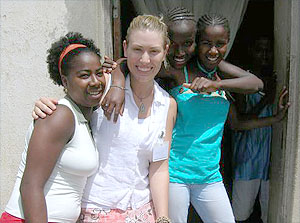
Brittany Kuhn with some new friends she made as a Peace Corps volunteer in Cape Verde in Africa.
For Brittany Kuhn (B.A. communications-journalism '06), becoming a Peace Corp volunteer was her mission.
“When I was 10, I decided I wanted to be a Peace Corps volunteer," she said. "It was a dream that always appeared visible just beyond the horizon.”
Shortly after graduating from Cal State Fullerton, she served two years in Cape Verde, just west of Senegal off the west coast of Africa.
“It is an elusive mix of everything,” she said of Cape Verde. “A blend of Portugal, Brazil, America and Africa, the archipelago consists of 10 unique islands that offer everything from isolated windswept beaches, mountainous misty forests, giant salt flats and black volcanic lava flows.”
While there, Kuhn served as an English teacher to seventh and eighth graders in a rural community located on the slope of a volcano crater.
“There were daily struggles," she said. "Living without running water and electricity are challenges that do not compare to the cultural adjustments necessary to thriving in community development work. But I must say, it was the best decision I ever made. The Peace Corps is a wonderful experience. It is, above all, about relationships. It is about finding yourself living in a place completely foreign to you, maybe a place you didn't even know existed, and watching in amazement as it becomes home.”
Early Days in the Corps
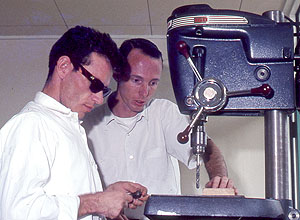
A blind man from Costa Rica learns how to use a drill press from Peace Corps volunteer Michael Riley in the late 1960s.
Michael Riley (B.A. psychology ’66), emeritus media production specialist in University Extended Education joined the Peace Corps just four years from its inception. He served two years in Costa Rica as part of a community development group.
“My first assignment was to work in the Centro Helen Keller in San Jose,” said Riley. “This was a rehab center for blind adults. We taught life skills, such as getting around town and using the bus system, cooking and washing, and engaging in some form of employment.
“There was much prejudice against the disabled at the time and convincing employers that these folks would make good employees was difficult,” Riley noted. “We did get one guy a job at an auto body shop pounding out dents and another at the hospital developing X-rays.
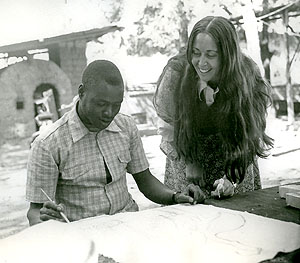
During her tour in the Peace Corps, Arline Riley taught painting to students like this young man from what was then the Upper Volta.
He worked there for almost a year before he was recruited to provide camera work with the USIA documenting Peace Corps projects in the country. Unfortunately, for Riley, he was only in the position for a couple of months before he was drafted into the Army. After his military service, he returned to his alma mater to take a position in the university's then Audio Visual Center.
“Despite the fact that my time was cut short, I enjoyed the experience," said Riley.
His wife Arline (B.A. art '71, M.A. art-sculpture '82) also remembers well her experience in the Peace Corps and is enthusiastic about the time that she spent in west Africa, mostly in Liberia. Arline served as a teacher — a career that she continues today. The Rileys plan to take part in an upcoming reunion of volunteers in Washington D.C. for the 50th anniversary of the Peace Corps.
A New Chapter of a Well-Lived Life
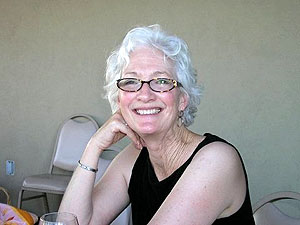
Suzanne Cochran, a 1969 Cal State Fullerton alumna, is looking forward to serving as a Peace Corp volunteer in the Ukraine. She is part of a “50+ Initiative” to increase the number of people who are turning to service after a full business career.
Suzanne E. Cochran (B.A. sociology '70) soon will be finding her own surprises. Cochran, 63, is leaving for the Ukraine later this month as one of the the growing number of volunteers who join the Peace Corps after several years in the business community.
“I didn't even think of the Peace Corps when I was young,” said Cochran, who spent 30 years in the corporate world and another decade as a personal chef and small business owner. “I got married while in college. … It wasn't in the scheme of things.”
In 1996, following a buyout from the telephone company, Cochran did go and get an application for the Peace Corps, “but I wasn't ready to commit to it at that time.”
She thought of it again in October 2007, when she was at a function and overheard two teens talking about serving in the AmeriCorps Program, a national community service program created in 1993. Cochran checked out the Peace Corps website and attended a recruiting event for the program's “50+ Initiative” to increase the number of older American's taking part in the program.
Cochran had been running a freelance business and beginning to feel the economic slowdown, so the timing was especially good for her. So, she jumped in with both feet and was invited to speak at a local recruiting event.
While she has traveled to places like France, Italy, Mexico and Canada, Cochran said that the Ukraine will be a new experience. She will be working in a community development capacity, most likely as a business adviser.
But first, Cochran is madly packing, settling last minute things and talking to old friends via email about the upcoming experience.
“I'm not going to miss material possessions very much,” she said, adding that she is fortunate to be renting a home, so there are no concerns on that front. Her cat sitter is moving in — and will take care of her 16-year-old cat.
And there is a bit of travel and sightseeing to do with her sister — Lorrie Harnach, coordinator of Cal State Fullerton's Testing Center — before she leaves March 30 from Philadelphia.
“It all has just kind of fallen into place,” said Cochran. “I had nothing to stop me from joining and felt I needed to shake up my life. It also was a way to make a difference, while I was able to do so. I am very grateful for the opportunity.”
If you’re a alumnus, faculty or staff member whose served in the Peace Corps. we’d love to hear about your experiences. Please email us at pasubmissions@fullerton.edu.

